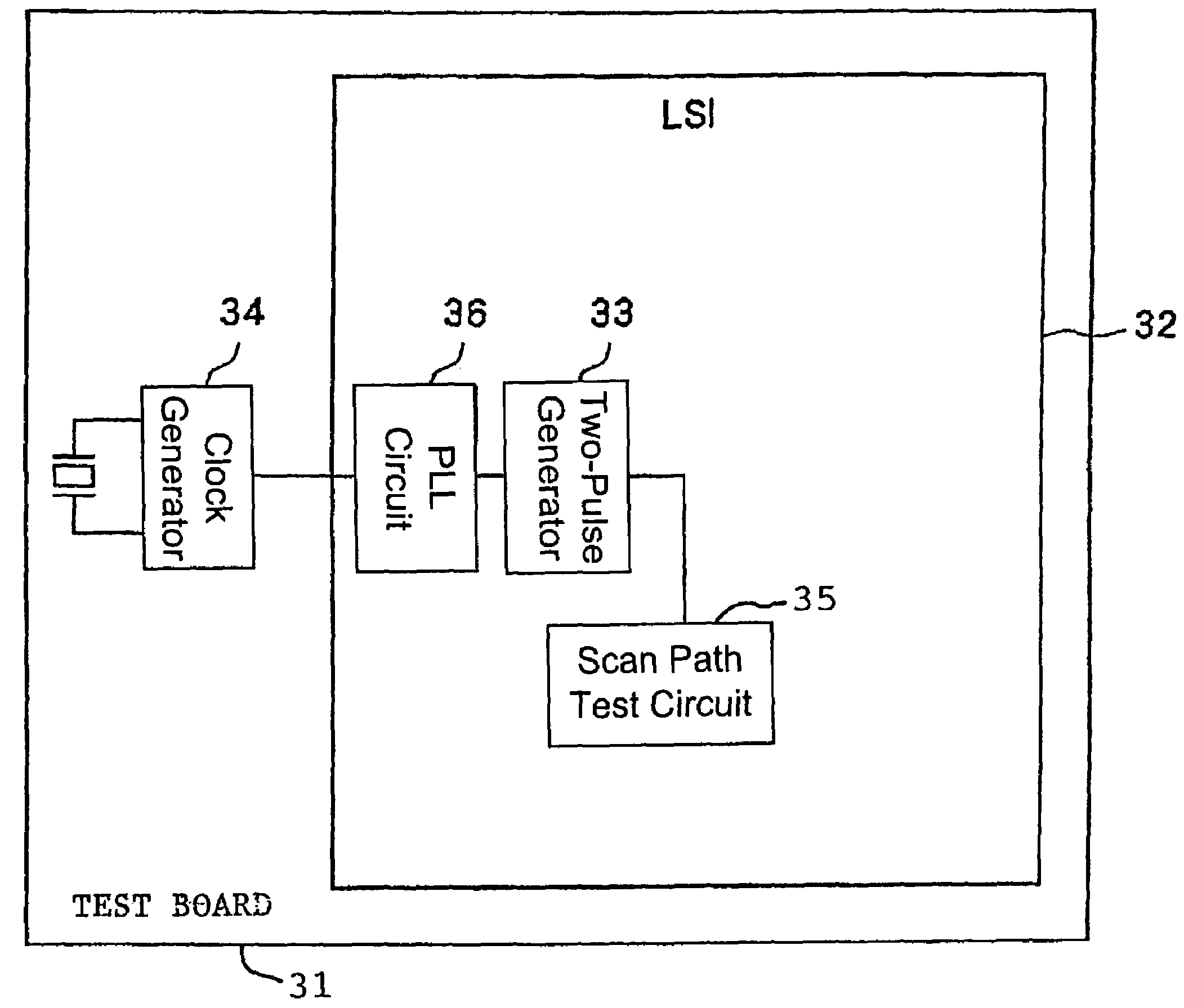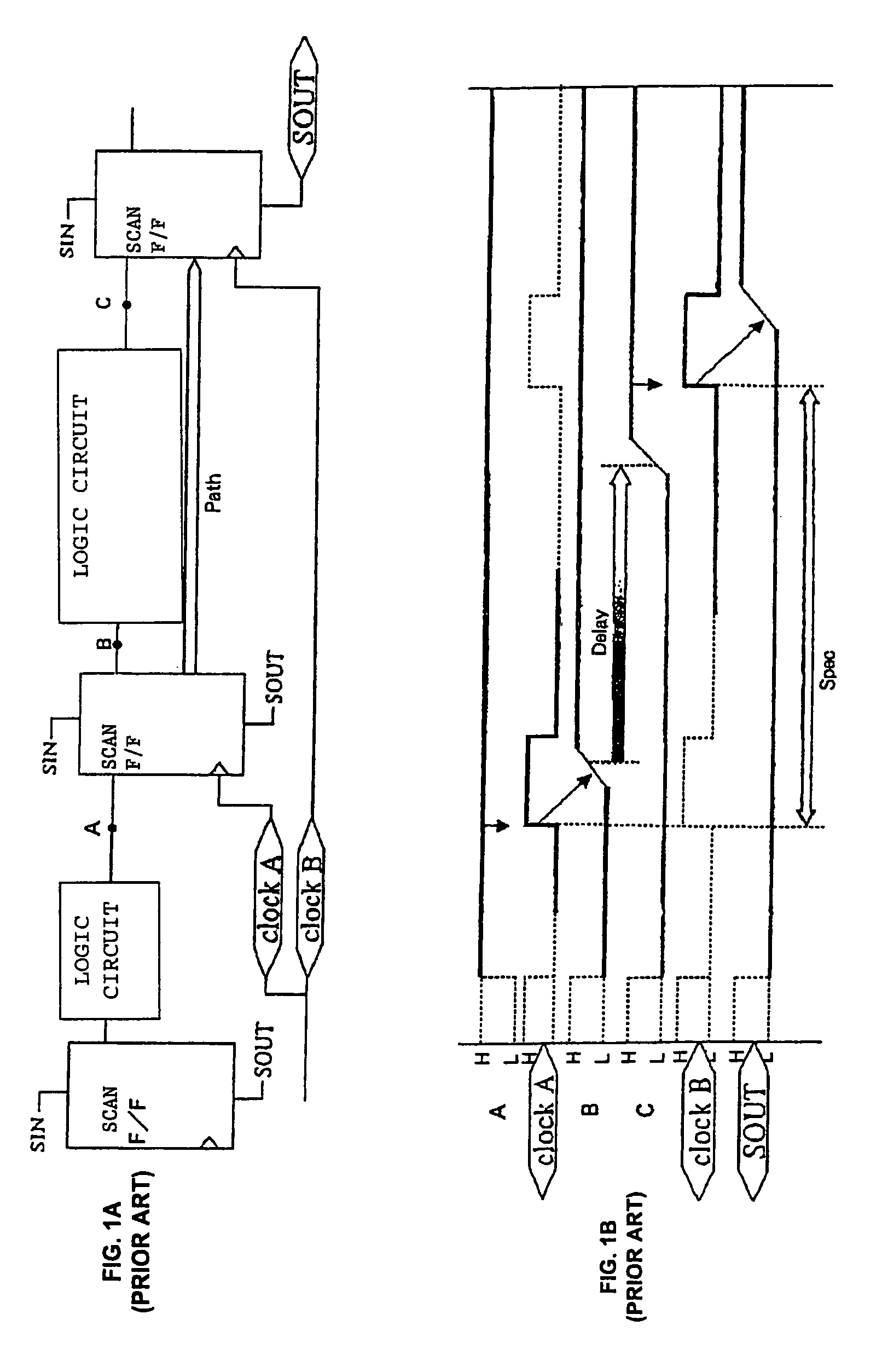Semiconductor integrated circuit device and device for testing same
- Summary
- Abstract
- Description
- Claims
- Application Information
AI Technical Summary
Benefits of technology
Problems solved by technology
Method used
Image
Examples
1st embodiment
[0036
[0037]FIG. 2 shows in block form a device for testing a semiconductor integrated circuit device according to a first embodiment of the present invention. FIG. 3 shows a two-pulse generator in the device shown in FIG. 2, and FIG. 4 shows the manner in which the two-pulse generator shown in FIG. 3 operates.
[0038]As shown in FIG. 2, the device for testing a semiconductor integrated circuit device according to a first embodiment of the present invention has test board 1 on which LSI chip 2 to be tested is removably placed, two-pulse generator 3 mounted on test board 1 for generating two pulses for a delay test which are to be supplied to LSI chip 2, and clock generator 4 mounted on test board 1 for generating a test clock for operating two-pulse generator 3 at a suitable timing.
[0039]Clock generator 4 generates a test clock having a frequency for use in a delay test. Two-pulse generator 3 extracts two pulses from the test block in timed relation to a control pulse input from an ext...
2nd embodiment
[0048
[0049]FIG. 5 shows in block form a device for testing a semiconductor integrated circuit device according to a second embodiment of the present invention.
[0050]As shown in FIG. 5, the testing device according to the second embodiment differs from the testing device according to the first embodiment in that two-pulse generator 13 which is identical to the two-pulse generator according to the first embodiment is incorporated in LSI 12 to be tested. The testing device according to the second embodiment has clock generator 14 which is identical to the clock generator according to the first embodiment. Therefore, details of clock generator 14 will not be described below.
[0051]With two-pulse generator 13 being incorporated in LSI chip 12, LSI chip 12 can be put to a delay test simply by supplying a test clock having a predetermined frequency from clock generator 14 or a general-purpose oscillator or a tester to the test board.
3rd embodiment
[0052
[0053]FIG. 6 shows in block form a device for testing a semiconductor integrated circuit device according to a third embodiment of the present invention.
[0054]As shown in FIG. 6, the testing device according to the third embodiment differs from the testing device according to the first embodiment in that PLL (Phase-Locked Loop) circuit 26 for multiplying the frequency of the test clock output from clock generator 24 and supplying a signal having the multiplied-frequency signal to two-pulse generator 23 is additionally mounted on test board 21. PLL circuit 26 may comprise a phase comparator, a VCO (Voltage-Controlled Oscillator), a loop filter, and a frequency divider, which are of known nature. Two-pulse generator 23 and clock generator 24 are identical to those according to the first embodiment, and will not be described in detail below.
[0055]In the third embodiment, since the frequency of the test clock output from clock generator 24 is multiplied by PLL circuit 26, the frequ...
PUM
 Login to View More
Login to View More Abstract
Description
Claims
Application Information
 Login to View More
Login to View More - R&D
- Intellectual Property
- Life Sciences
- Materials
- Tech Scout
- Unparalleled Data Quality
- Higher Quality Content
- 60% Fewer Hallucinations
Browse by: Latest US Patents, China's latest patents, Technical Efficacy Thesaurus, Application Domain, Technology Topic, Popular Technical Reports.
© 2025 PatSnap. All rights reserved.Legal|Privacy policy|Modern Slavery Act Transparency Statement|Sitemap|About US| Contact US: help@patsnap.com



